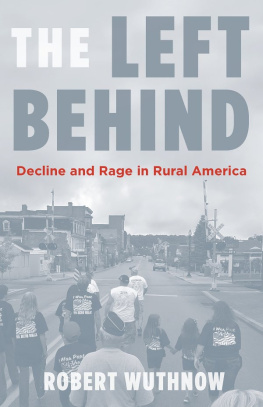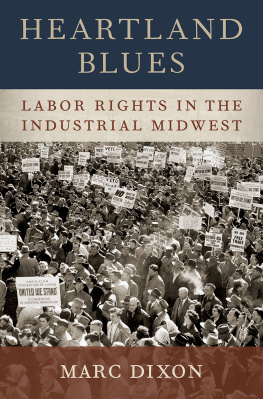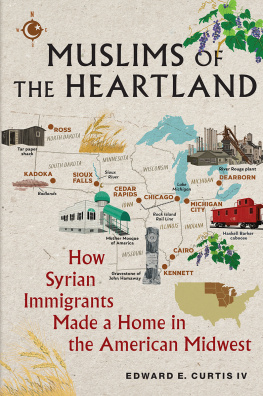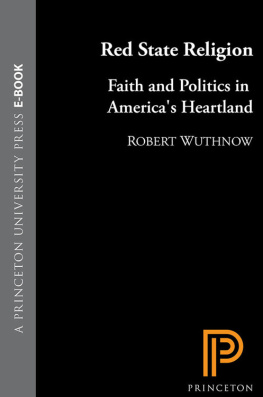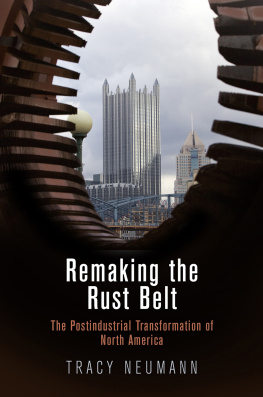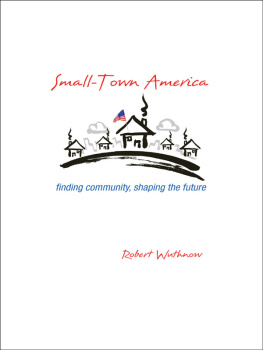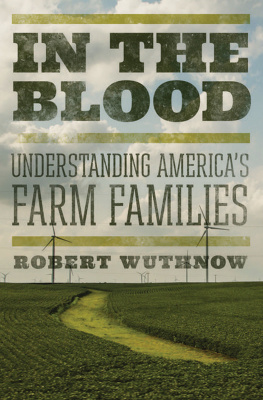Copyright 2011 by Princeton University Press
Published by Princeton University Press, 41 William Street, Princeton, New Jersey 08540
In the United Kingdom: Princeton University Press, 6 Oxford Street, Woodstock, Oxfordshire OX20 1TW
press.princeton.edu
All Rights Reserved
Library of Congress Cataloging-in-Publication Data
Wuthnow, Robert.
Remaking the heartland : Middle America since the 1950s / Robert Wuthnow.
p. cm.
Includes bibliographical references and index.
ISBN 978-0-691-14611-9 (hardback : alk. paper) 1. Middle WestEconomic conditions. 2. Middle WestSocial conditions. 3. AgricultureMiddle West. 4. Social changeMiddle West. 5. Community developmentMiddle West. 6. AgricultureEconomic aspectsMiddle West. I. Title.
HC107.A14W88 2011
330.977dc22
2010021518
British Library Cataloging-in-Publication Data is available
This book has been composed in ITC Century Std
Printed on acid-free paper.
Printed in the United States of America
10 9 8 7 6 5 4 3 2 1
Preface
It may have been that cold windy morning in central Nebraska when I pulled off the highway to watch the sun rise, golden red, across the open fields. That may have been the day I decided to write this book. Or it may have been another day, when I was driving through small towns in eastern Iowa. That moment, perhaps, when a highway marker reminded me of my childhood home. Or it may have been only the slow realization that something there in the nation's heartland was calling me to write about it. Who knows?
What I do recall as vividly as if it were yesterday is listening to a public lecture by a visiting speaker at my university, my mind wandering as it often does, and realizing that I had it all wrong. Well into the research at that point, I was working on the assumption that the heartland was a place of withering decline, like the soil itself gradually eroding away. I thought that was the story that needed to be told. It made sense of small towns with empty storefronts. Large fields with no farmsteads. Reports of joblessness. But it did not square with other evidence. New technology. A surprisingly robust economy. Strong schools. An upbeat feeling among residents about the future. Clearly I needed to think harder about what was happening. By the time I finished with the research, I had a much different story in mind than when I started.
My central claim is that the American Middle West has undergone a strong, positive transformation since the 1950s. The reshaping that occurred in this period is striking because the region was worse off in the years immediately following World War II than has commonly been assumed. The transformation is surprising because it took place in the nation's heartland. Most accounts of dramatic social change have focused on other parts of the countryespecially the Sunbelt and coastal citiesnot on the Middle West, a region of small towns and farms, wheat fields and prairies. The transformation that occurred here was largely beneficial, notwithstanding the fact that millions of people were displaced from their communities, because this displacement resulted in new opportunities for employment and a healthier relationship between the region and the rest of the nation. By the first decade of the twenty-first century, the Middle West was a more vibrant contributor to the national economy than it had been a half century earlier.
This argument, I confess, is counterintuitive. The typical approach is to regard the American Middle West as a kind of throwback to earlier times, a vast museum of dwindling farms and small towns to be visited by folks who live elsewhere and would not want to stay for very long. The view that things were better in the past fits neatly with a nostalgic image of an America that was in fact rural and less complicated than it is today. A related view popularized in news magazines and schoolbooks showed a heartland in the 1950s prospering from good crops, with happy housewives preparing luscious meals on modern kitchen appliances for grateful husbands and childrena time followed by disappointment and decline. That image of the 1950s may have been true for the few but not for the many. A better sense of how the Middle West has changed over the past five or six decades is gained by thinking of the 1950s as a time when many families were still recovering from the Great Depression. Farmers were again suffering from dust storms, uncertain crops, and wildly fluctuating prices. Farm communities often lacked paved roads, electricity, or dependable telephone service. Millions of people were leaving the farms and rural communities in search of meager employment opportunities elsewhere.
It is also counterintuitive to argue that the Middle West is vibrant economically and culturally. Most depictions of the region's recent history view it as a sad tale of rural people clinging to outmoded lives, of dying communities, and of old- fashioned values tinged with bigotry and ignorance. When writers who pass briefly through the region find other stories to tell, the stories are usually about food the writers romantically wished was still grown in the family garden, smelly feedlots, or undocumented workers being exploited by rich agribusiness owners who reap unjustified millions in government subsidies. But these accounts miss the fact that the region has upgraded itself even as it has downsized. The technology, the new industries, and the cultural diversity of the heartland could hardly have been imagined a half century ago.
The transformation that has occurred in the American Middle West cannot be attributed to any single cause, tempting as it may be to seek answers in the magic of, say, rugged individualism. I break the narrative into several parts. The first is about the struggles of Middle Western farmers in the 1950s. Difficult as those struggles were, they enabled farming to become more efficient and capital intensive. The second is a saga of cultural redefinition. As the Middle West modernized, it rediscovered its legends of hardy pioneers, adventuresome cowboys, and Dust Bowl survivors. It reshaped these legends into a less spatially confined image of congeniality and can- do inventiveness. These new understandings improved the region's self- image and contributed to its ability to transform itself. A third story is about public education. The region invested heavily in schools, administered them well, and encouraged children to regard school achievement as their best hope for occupational success. Higher education became the source of both upward and outward mobility. A fourth story tells of small communities that are dying by the hundreds and yet are not doing so very quickly or completely. Community downsizing has been a matter of great concern to the residents of these communities, but it has worked remarkably well for the region as a whole. Small communities remain attractive for low-income families needing inexpensive housing. Many of these communities are within commuting distance of larger towns where work can be found in construction, manufacturing, and human services. High fuel prices are making it harder for these commuters, but electronic technology and decentralization are opening new opportunities. A fifth story examines the growth of large- scale agribusiness and its effects on the ethnic composition of the region. Contrary to tales about extreme ethnic conflicts, the picture that comes into focus from closer inspection is one of greater diversity over a longer period, continuing difficulties for immigrants and undocumented workers, and yet shows a striking degree of communitywide accommodation to new realities. A final story is about the phenomenon least expected in this part of the countyrapidly expanding edge cities. The growth of these communities has been nothing short of spectacular. And yet the sources of this growth lie in more than simply the availability of land and the decline of smaller towns.


